-
Raijintek Cratos 1200W
Introduction
There are a lot of great PSUs hitting the market recently, what with the recent-ish switch up to the latest PCI Gen 5.0 and ATX 3.0 standards, and with newer CPUs and GPUs using a huge amount of power, weíre seeing 1000W+ PSU become the norm again. Like many other manufacturers, Raijintek also promptly adapted its offer to the ATX 3.0 and PCIe 5.0 standards, offering the new Cratos series in three power ratings, specifically 850W, 1000W and 1200W, all with 80Plus Gold and Cybenetics ETA Gold certification and guaranteed for 5 years. All three are also available in a white and a black colour variant. The unit is kept cool by a 120mm fluid dynamic bearing fan which uses Smart Zero Fan technology. The subject of today's review is the flagship model of the series, the 1200, capable of supporting power peaks of 2400W in accordance with the ATX 3.0 standard!
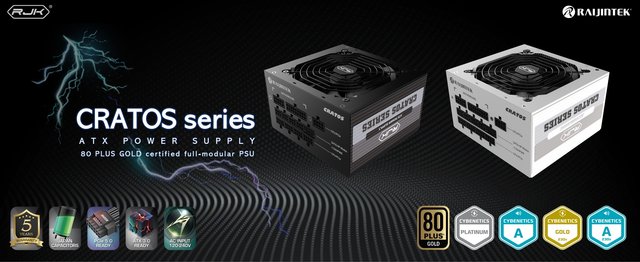
Before starting with our analysis we report, as usual, the amperometric data of the models belonging to the Cratos series. These power supplies provide several protections including OCP, OVP, UVP, OPP, SCP and OTP.
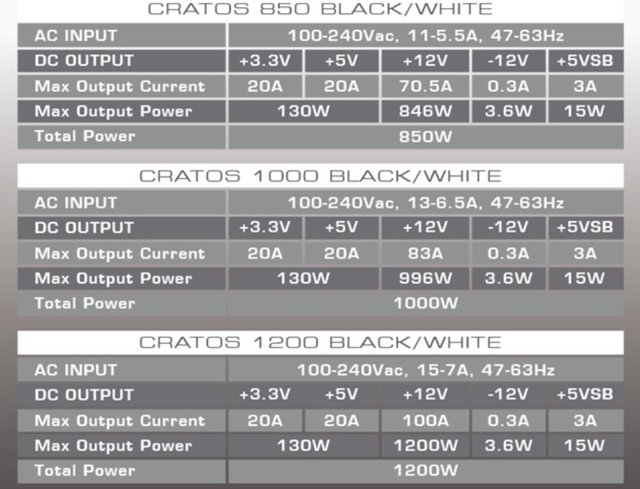
Packaging & Contents
The Raijintek Cratos 1200 box is colourful with some key points listed including ATX 3.0 Ready, PCIe 5.0 Ready, and 80 Plus Gold certification Ė alongside the use of Japanese capacitors. At the face of the box is the PSU's model name.

On the back are details about the PSU's cables, dimensions, a series of badges depicting various features, and power specifications.

On the left side the manufacturer expose the name of unit

On the right side the manufacturer expose the three available models in black and white versions(850W, 1000W and 1200W)

Protection inside the box is good, and the PSU is also wrapped in plastic. The Raijintek Cratos 1200 is well packaged with black layered foam around the entire PSU.

Raijintek has shipped all the included cables in this branded black bag.

Here, you can see the entire bunch. Some of you will enjoy the view. The cables are all black and come in electrical and nylon braid with heat shrink wrap, so they fit most usersí needs. They are sufficient in terms of number and length as well. Four 6+2 pin PCIe cables are included, measuring 650 mm. The other connectors common to all models include a 24-pin ATX, two 4+4 pin EPS, eight SATA power connectors, three 4-pin Molex, and a Berg (FDD).

The 12+4 pin PCIe is 600 mm long. The 24-pin ATX motherboard cable is 600 mm long, whereas the 8-pin ATX CPU leads are 70/60 cm long. SATA is 900 mm long, and the Molex lead is 820 mm. These cables are modular, so you wonít have to plug in the ones you donít need in your system, reducing cable clutter in your PC.

Also, you get a leaflet and four screws.

A Closer Look
The Raijintek Cratos 1200 power supply is nicely finished in a neutral colour scheme to fit into any themed build. Many new chassis hide the power supply anyway, so its not so much of an issue now. Measuring only 140mm deep, this PSU is compact for the capacity. The fan is hidden behind a metal grill, with the Raijintek badge in the centre. A 120 mm fluid-dynamic bearing fan is used to keep cool, which is programmed to stay completely off until a certain load level. The wide 8mm spacing between fan grill and the fan blades guarantees low influx turbulence and better airflow performance while lowering noise.

On the left side, a sticker describes the model name.

On the right side, a sticker describes the power specifications.

The exhaust/front utilizes a typical honeycomb grille, and the power switch.

The modular bay on the other side of the unit is clearly laid out and labelled for ease of use during the build phase. Input cable plugs here have a split 12+18-pin design for the 24-pin motherboard cable. Next, a single CPU/PCIe 8-pin cable input rounds out the top connections. The second row consists of four 6-pin SATA or MOLEX cable inputs and a full 600-watt 12VHPWR cable. The last row has more combination CPU/PCIe 8-pin cable inputs, making for five.

A Closer Look Inside
The OEM of this PSU is SANR, which probably doesn't ring a bell for most of you. Its other name is Casecom. There is one big aluminium heatsink, covering the PFC MOSFETs, and the AC/DC rectifiers. Soldering quality is decent.

The transient filter starts on the AC receptacle and continues on the main PCB. There is an NTC thermistor for suppressing large inrush currents. I didn't expect it to be supported by a bypass relay. The Y-caps in front of it reduce EMI.

12V MOSFETS are all soldered on the top of the PCB, along with a small heatsink. The temperature sensor is directly mounted on the 12V MOSFETís heatsink, which is a really good sign.

There are two main bulk capacitors in this power supply, helping it reach the massive 1200W output. Theyíre 420v rated at 390 uF for a total of 780uF. All the capacitors are high-quality Nippon Chemi-Con Japanese capacitors, which is great to see. It is reassuring to see the adoption of 105c rated. There are some mid-size capacitors here too, such as these 16v 2200 uF.

Instrumentation used
Below we report the instrumentation used in the test phase for Raijintek Cratos 1200W.

PowerKiller 2.0. Test bench designed for power supplies up to 2185W.
Stingray DS1M12 USB Oscilloscope
PCE-PA 6000 Wattmeter
Range 1W ~ 6kW
Accuracy Ī 1.5%
Multimeters
3 x HT81
1 x ABB Metrawatt M2004
1 x Eldes ELD9102
1 x Kyoritsu Kew Model 2001
1 x EDI T053
Scythe Kama Wireless Thermometer
Center 325 sound level meter
Voltage Regulation
The voltage regulation tests are carried out by connecting all the electrical lines to our PowerKiller, simulating the behavior of the power supply with loads comparable to those of a real workstation.
Line +3,3V

Average Voltage 3,233 volt
Deviation from the ideal value (3,33 volt) = -2,91%
Line +5V

Average Voltage 4,980 volt
Deviation from the ideal value (5,0 volt) = -0,40%
Line +12V

Average Voltage 12,036 volt
Deviation from the ideal value (12,0 volt) = +0,30%
The linear load test also confirms what was already seen in the previous test. The 12 and 5 volt voltages remain close to the nominal value throughout the entire operating range. On the 3.3V line a slightly lower value is observed due to the starting value of "only" 3.31V, however, even at full load, the voltage remains within the limits imposed by the ATX standard.
Efficiency
The 80Plus Gold certification is well deserved, the Raijintek Cratos 1200 has reached the threshold of the superior certification with an excellent 93.5% at 600W.
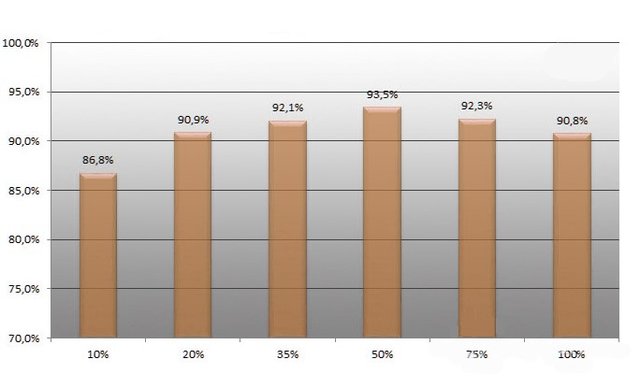
Ripple
The ripple on this PSU is quite high. Is it so high that Iím worried about it? No, the 12V rail should be under 50mv, and the other rails under 150mv, and theyíre certainly under that. However, compared to a lot of other units Iíve tested recently it is certainly noisier.

Cross Load
Line +3,3V



Maximum Vdrop 0,07 volt (2,11%)
Line +5V



Maximum Vdrop 0,06 volt (1,18%)
Line +12V



Maximum Vdrop 0,18 volt (1,48%)
The first test session, which aims to verify the stability of the voltage supplied on the individual lines, is archived with excellent results. The Raijintek Cratos 1200 contains voltage drops within 2% on two of the three lines of interest, with an "imperceptibly" higher value on the 3.3V one. I nteresting to note that on the 12V line at low load there is an increase in the output voltage within 10A of supply.
APFC & OverLoad
The power factor control system (APFC) at full load reaches a value of 0.99, with an excellent progression, reaching 0.98 already at 50% load.

The output voltage on the 12VHPWR cable contains the voltage drop compared to the no-load value in just 120mV at full load. This is partly due to the increase in voltage at low load. However, the fact remains that we are faced with one of the best results seen so far. All we have to do is move on to the overload test to verify the effectiveness of the protection systems.

Although the power supply is compatible with the ATX 3.0 standard, therefore capable of supporting peaks of 200% (2400W) for 100 μs, the protection system intervenes promptly if the surplus power persists over time. The efficiency detected in overload was 89.5% with a power absorbed from the electrical network of approximately 1565W. The 3.3V voltage is the one that has suffered the most, coming close to the lower limit set by the ATX standard. As always, we reiterate that the overload test is carried out by us for the sole purpose of ascertaining the quality of the internal circuitry and protection systems, which is why we recommend choosing the power supply based on the real needs of your workstation without relying to its ability to work off specification.

Noise
The fan on this PSU is pretty active, easily spinning faster than most I test. The unit is kept cool by a 120mm fluid dynamic bearing fan which uses Smart Zero Fan technology to ensure the unit does not produce any unwanted noise under low loads. Despite spinning up pretty fast, it seems surprisingly quiet, no louder than a typical case fan, so even at high loads, youíre unlikely to be bothered by it over say your CPU or GPU cooler. However, there is still clearly room for improvement, I doubt it needed to spin that fast.
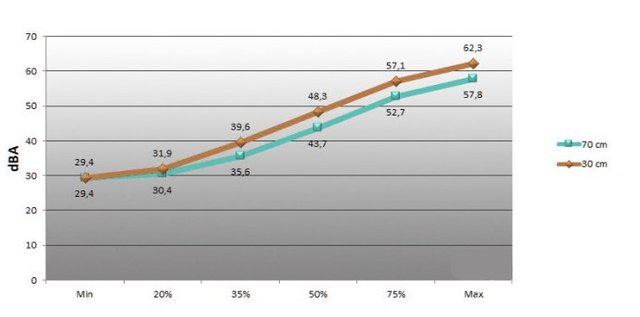
Temperature
In general, the thermal performance of the PSU is satisfactory. Nevertheless, itís worth noting that the area at the back where the transformer is located experienced a notable increase in temperature, reaching approximately 54 degrees. This observation is somewhat concerning, especially considering that the testing was conducted at an ambient temperature of 26 degrees. While this temperature at the hottest part of the body is a bit worrying, itís not excessively high.
Final Thoughts
Raijintek enters the PSU ATX 3.0 world with this new power supply with excellent premises, fully confirmed during our analysis. Thereís no silly RGB here or anything like that, itís just designed to be a powerful power supply that isnít going to break the bank. Itís built to handle big power spikes, with an increased hold-up time, and also features the latest PCIe Gen 5 12VHPWR connector to support the latest Nvidia GPUs, and likely many future models, without the need for those awful PSU adaptors. It has a shorter depth than many PSUs of this output at just 140mm, so itíll have impressive compatibility.
Raijintek opted to reduce costs by adopting a platform provided by SANR/Casecom. Itís intriguing because we donít get to see these types of platforms very often. They use only top-of-the-line quality components. This approach keeps costs relatively low while delivering a high price-to-performance ratio. By combining these factors, they elevate what would be a merely adequate platform to an exceptional quality one. The result is outstanding PSU performance at a relatively lower cost compared to competitors. This half-bridge LLC resonant converter + DC-DC topology has high output efficiency and stable voltage regulation. It does have some higher ripple than the competition on the 12V rail, itís not so high that I think itís cause for concern, but thereís still room for improvement regardless. The unit runs pretty cool due to the excellent 120mm fluid dynamic bearing fan, and the adoption of 105C-rated high grade Japanese capacitors from Nippon Chemi-Con should ensure long term stability. The only negative note concerns the noise, essentially due to the combination of power and energy efficiency, as the cooling system will have to dispose a lot of thermal power at full load. The fan spins a little fast but surprisingly didnít seem all that loud despite the over-active cooling, and the PSU was even that warm anyway. It must be said, however, that most of the time the power supply will remain practically inaudible thanks to the Smart Zero Fan technology.
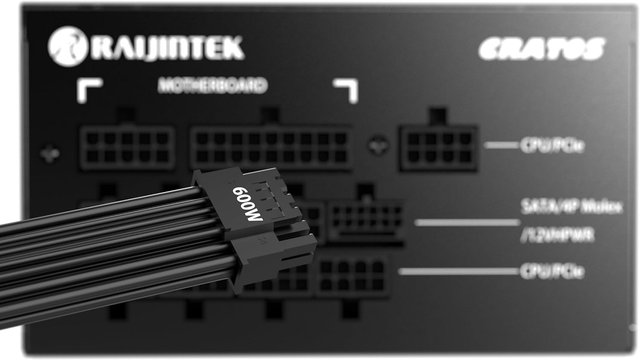
The Raijintek Cratos 1200 comes at a competitive price of 150Ä. The main reason behind this low price is the platform that they have used from OEM, but with their top-of-the-line components, they were able to achieve a compelling price-to-performance ratio. Despite its competitive pricing, it offers a respectable balance of performance and features, making it an attractive option for those aiming to build or upgrade their gaming systems without breaking the bank. If you want a compact ATX PSU that can drive big wattages to deal with the 600W 12VHPWR and still have enough juice to power some of the latest flagship CPUs, itís a good choice for a gaming system that you plan to max out on a daily basis.

 Posting Permissions
Posting Permissions
- You may not post new threads
- You may not post replies
- You may not post attachments
- You may not edit your posts
-
Forum Rules













































 Reply With Quote
Reply With Quote

Bookmarks